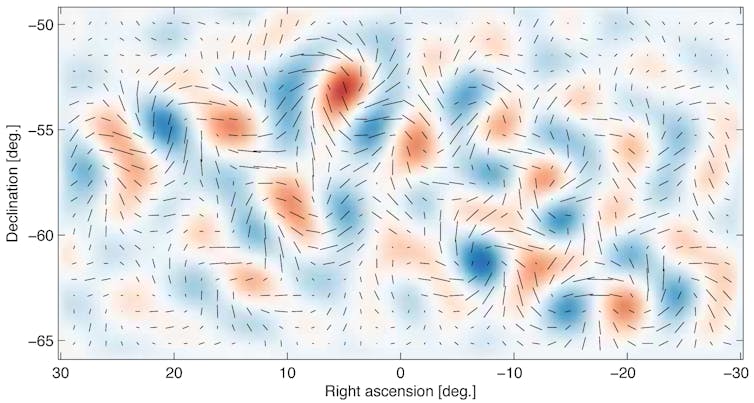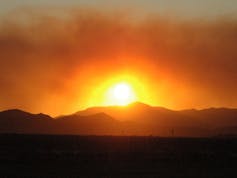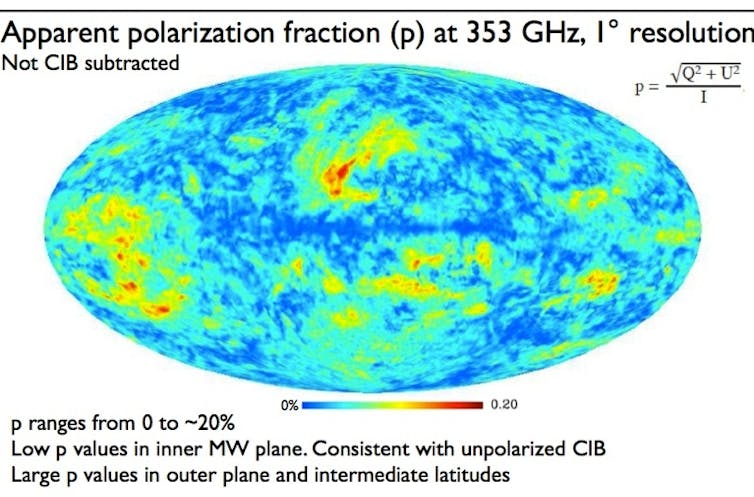It’s almost three months since a team of scientists announced it had detected polarised light from the afterglow of the Big Bang. But questions are still being asked about whether cosmic dust may have clouded their discovery.
The latest, and most damning, piece was in Nature News last week.
What made the original announcement from the Background Imaging of Cosmic Extragalactic Polarisation (BICEP2) team so exciting was that the twisting pattern on the sky could be caused by gravitational waves.
If true, as we wrote on The Conversation at the time, then these gravitational waves could come from the very earliest times in our universe, a trillionth of a trillionth of a trillionth of a second after it all began. The twisting pattern would be a unique window into these early times.

But as the US astronomer Carl Sagan pointed out: “Extraordinary claims require extraordinary evidence.” As much as there was excitement over the BICEP2 announcement, there were also many questions.
And then it all went crazy
A blog post in early May was one of the first to question whether the BICEP2 team might have incorrectly interpreted their data (which they completely deny incidentally).
But it sparked further articles in Nature, Science and NewScientist.
There were excellent, more nuanced summaries in the Washington Post and blogs by physicists Richard Easter and Sean Carroll to name but two who investigated the claims surrounding the result.
It is normal that scientists debate their new findings and confront them against existing theories and data. This is how science works. Such peer-review is a key aspect of the successful, centuries old tradition of the scientific method.
Ordinarily such scientific debate attracts little attention. But with a discovery that could explain the earliest moments of our universe, the stakes were high, and things became very public.
What about the dust?
At the heart of this heated discussion is something quite cold – cosmic dust.
The light from the Cosmic Microwave Background (CMB) has to pass through a lot of intervening material as it travels for nearly 14 billion years to reach our telescopes.
Our galaxy, in particular the cold dust grains drifting within it, is a very important source of confusion when trying to understand just how much of the light hitting the telescope is from the CMB and how much from the stuff in the way.

Think of trying to take a picture of a beautiful sunset in a sandstorm and you’re getting close.
How you account for dust in our galaxy is crucial. Do it wrong and you can mistake it for the signal you want to find. The best way to remove this dust from the signal is to map the sky in many frequencies (or colours) of light.
The BICEP2 team only had one frequency available in a bid to maximise how sensitive a picture they could make. They then relied on other measurements of the dust to make up for this.
The European Space Agency’s Planck satellite is currently doing just this. Unfortunately, this data is not fully processed yet for general use.
A quest for dusty image
So the BICEP2 team decided to estimate the amount of dust using theoretical models, as well as any data available at that time.
One such measurement – and this is where things get messy – is a digitised powerpoint slide (below) of a Planck work-in-progress map of the sky shown at a conference talk.

This is certainly unusual and not to be encouraged (especially as it was preliminary analysis) but not necessarily cause to throw out the result.
However, meticulous reanalysis of both the Planck picture and BICEP2 data by Princeton physicist Raphael Flauger (whose talk you can watch here with slides here) show that BICEP2 has likely been overly optimistic about the level of contamination from the dust.
A paper that presents this analysis suggests that for all but the lowest estimates of the confusing signal from the dust, the BICEP2 results show no strong evidence for gravitational waves.
Yet, as was the case two months ago, Planck (and others currently running experiments) will have the final say on all this.
What lessons we can learn?
Now the dust is settling on BICEP2 (or at least until Planck releases its results in October) we can ask two important questions, regardless of what has or has not happened within the team’s analysis:
what happens if Planck shows BICEP2 to have been right? Who will get to make the claim of the detection as now, seemingly, without Planck no one can actually be sure that BICEP2 was correct?
how has the debate impacted the public’s view of science, from the high of the initial announcement to the low of the blog-based questioning and criticism?
As a community, we have to decide whether high profile announcements made before publications are peer-reviewed run the risk of the public becoming jaded of science, especially if claims are later retracted.
Or perhaps gaining the public’s attention is worthwhile, along the lines of Irish wit Brendan Behan’s remark: “There’s no such thing as bad publicity, except your own obituary.”
Discoveries and debates such as this one will always attract public and media attention. This can only be good for science so long as the public understands that real science is never a straightforward process. It is a slow, diligent process and for every big step forward there are a few back.
There will be discussions and disagreements among scientists along the way. That’s all just part of the process of trying to advance the boundaries of our knowledge.

